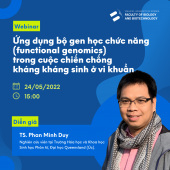Seminar/Hội nghị
Buổi giới thiệu chương trình thực tập từ xa của Virtual Internships
Seminar và Giới thiệu chương trình học bổng đại học Tsukuba, Nhật Bản
Webinar Ứng dụng bộ gen học chức năng (functional genomics) trong cuộc chiến chống kháng kháng sinh ở vi khuẩn
Chủ tọa: PGS.TS. Trần Văn Hiếu
Thời gian: 15 giờ ngày 24/5/2022 qua nền tảng Zoom (ID và pass sẽ cung cấp cho người đăng ký qua email)
Hội thảo Quốc tế về Chẩn đoán phân tử trong Vi sinh và Bệnh
Tiếng Việt: “Gặp gỡ Quy Nhơn lần thứ 1: Hội thảo Quốc tế về Chẩn đoán phân tử trong Vi sinh và Bệnh ”
Tiếng Anh: “The first Rencontres de Quy Nhon: International Workshop on Molecular Diagnostics in Microbiology and Diseases (MDMD-2022)”
Đường link: https://www.icisequynhon.com/conferences/2022/1st-MDMD/index.html
OUCRU Open Day Webinar
Đơn vị nghiên cứu lâm sàng ĐH Oxford tại Việt Nam (Oxford University Clinical Research Unit – OUCRU) trân trọng kính mời các bạn sinh viên, giảng viên Khoa Sinh và Công nghệ Sinh học tham dự Hội thảo online Open Day tổ chức tại OUCRU, vào 17/05/2022, lúc 14.00 pm. Đăng ký tham dự tại link https://forms.gle/JerGtnC7RiLLeEYeA
[Webinar] Ion transport in stomata – From mechanism to the potentials in improving plant fitness
Abstract
Most living activities on Earth are fueled by a phenomenon occurring in plant, algae, and some groups of bacteria, the photosynthesis. This process uses energy from light to convert CO2 to sugar and releases O2 as a byproduct. To acquire CO2 required for photosynthesis, higher plants have to trade off their precious water through evaporation. Maintaining the balance between controlling water loss and uptaking CO2 for photosynthesis is a crucial task assigned for stomata, the microscopic pores formed by pairs of guard cells on the leaf surface. Since the first observation of potassium accumulation in the pair of guard cells in 1905 by Macallum, the mechanism controlling stomatal movement has been intensively studied. More than a century of research has revealed a complex picture of how plant sophistically manipulates the aperture of these tiny pores in response to environmental stimuli. The wealth of knowledge about guard cell ion transport in the model plant Arabidopsis allows researchers to explore the more complex stomatal structure often found in many important crop species. Understanding the mechanism controlling the function of those stomata potentiates the enhancement of the crop plant fitness, which in turn, will have a strong impact on the food security.
Hội thảo hè 2022 trực tuyến - Toyota Technological Institute, Nhật Bản
[Webinar] Plant-based anticancer drugs - from discovery to final product
[WEBINAR] Targeting tumor cell metabolism and the epigenome for brain tumor therapy
Abstract: Targeting tumor metabolism for therapeutic strategies has emerged over the last decade due to a display of reprogrammed metabolism such as glycolysis, the citric acid cycle (TCA-cycle), and fatty acid. Key contributing factors of the resistance to therapy are the heterogeneity of these tumors, diffuse and infiltrative growth, the presence of the blood brain barrier, and likely the plasticity of these tumors to reactivate alternate survival pathways. A rational therapeutic approach with improved central nervous system (CNS) penetration and extend patient life expectancy can be exploited by using genetic and pharmacological inhibition of the oxidative metabolic reprogramming and conducting high throughput drug screening.
Chương trình giới thiệu công ty Yakult và Lễ trao học bổng Minoru Shirota 2021
Hội thảo trực tuyến “Textile Engineering Weaves the World” - KIT Fiber and Textile Science Seminar - Winter 2021 Online
- Thời gian: 20 & 21 tháng 12 năm 2021





![[Webinar] Ion transport in stomata – From mechanism to the potentials in improving plant fitness [Webinar] Ion transport in stomata – From mechanism to the potentials in improving plant fitness](http://www.fbb.hcmus.edu.vn/vnt_upload/news/04_2022/thumbs/170__Webinar.png)
![[Webinar] Plant-based anticancer drugs - from discovery to final product [Webinar] Plant-based anticancer drugs - from discovery to final product](http://www.fbb.hcmus.edu.vn/vnt_upload/news/03_2022/thumbs/170__Webinar.jpg)
![[WEBINAR] Targeting tumor cell metabolism and the epigenome for brain tumor therapy [WEBINAR] Targeting tumor cell metabolism and the epigenome for brain tumor therapy](http://www.fbb.hcmus.edu.vn/vnt_upload/news/02_2022/thumbs/170__Webinar.jpg)



